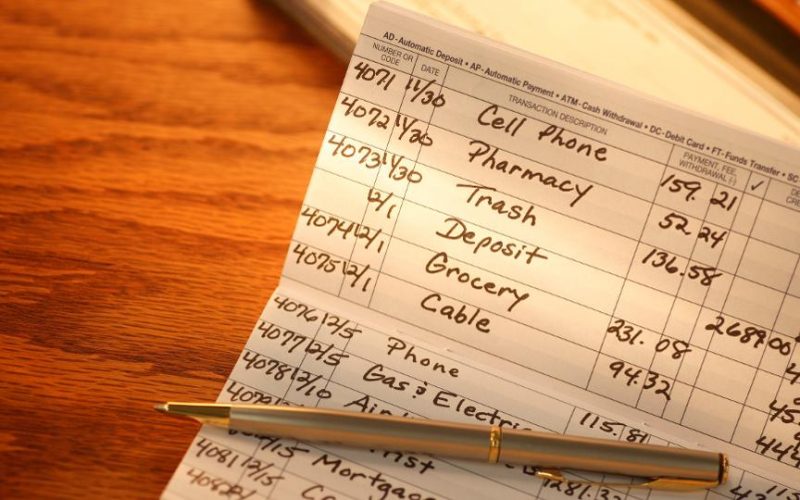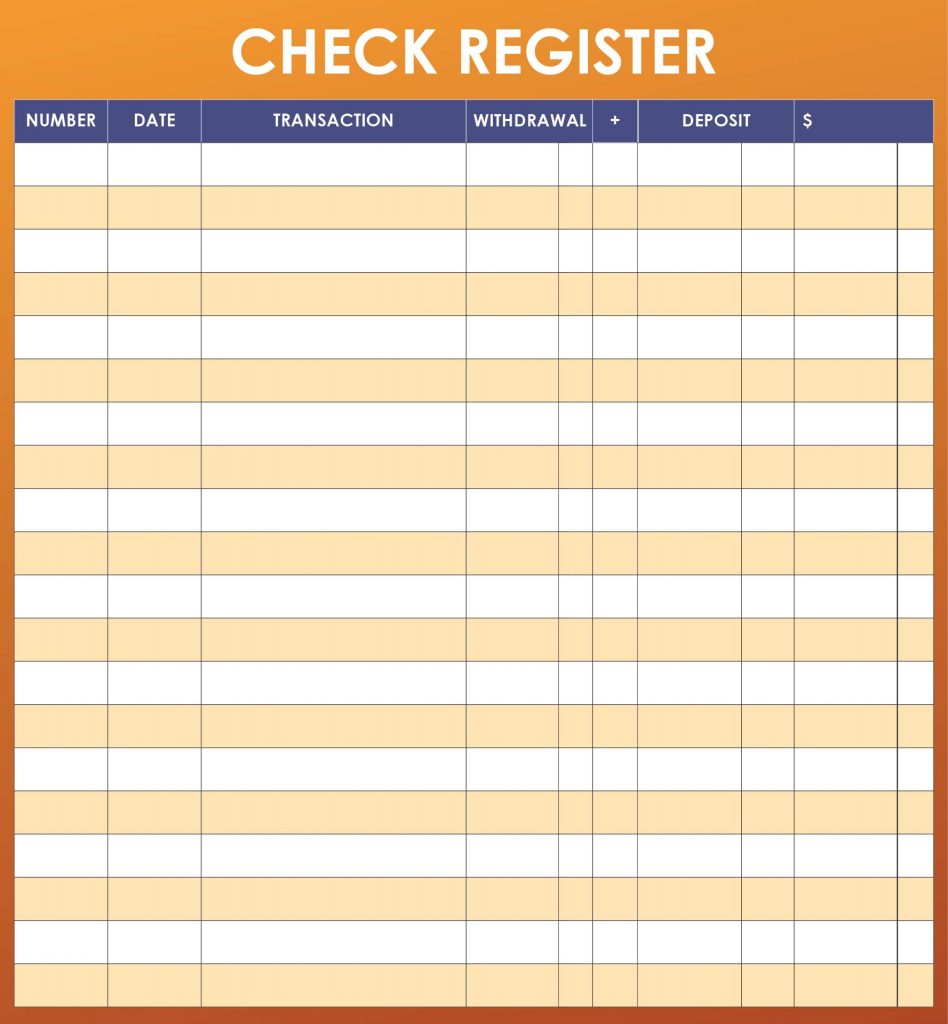As a small business owner, you understand the importance of keeping track of your company’s finances. However, your company bank statement may not always be up to date with the most recent information. A check register can provide you with an up-to-date snapshot of your transactions. So, what exactly is a check register? Read on to discover more about a check register and the best check register app for your small business.
What is a Check Register?
A check register, also known as a cash disbursements log, is where you record all of your company’s check and cash transactions over the course of an accounting period. A check register is used by businesses to calculate the running amount of their checking account.
Depending on the needs and preferences of your company, you may want to keep a separate business check register for each checking account (e.g., payroll account and operating account check registers).
Columns in a cash disbursements log let you organize and categorize transaction information.
What Does a Check Register Include?
When you write a check, you must enter it into the check register. Almost every check register is the same and contains titles that are identical. Check the common titles found on a check register.
#1. Check Number
This is the number printed on the right side of the check. It is also on the bottom of several checks. Checks are typically arranged in chronological order. This is why, even if you make a mistake or an error, there is no harm. You can simply write the check number and ensure that no checks are missing.
#2. Date
Today is the day when you write the check. You must ensure that you write the exact date, as the individual for whom you are writing may not get the cash in their bank deposit if you make a mistake.
#3. Transactional Description
This is the description that determines who receives the check. You can call it whatever you like. In general, start the transaction description with the person’s name. For example, if you are working with a store for your company, include their name in the description.
#4. Amount
This is the amount of money written on the check. In the section, you must include the precise payment. Whether you paid with a debit card, a credit card, or through internet banking, you must verify that the precise amount of the payment is entered in this box.
#5. Withdrawal Amount
This is the amount of money you drew from the bank for whatever reason. You must guarantee that you type the entire and accurate amount.
#6. Fee Amount
This is a list of any fees that may have been charged during the transaction. For example, if you withdraw money from an ATM, you will be charged additional fees called service costs. This is the amount that has nothing to do with the bank or the transaction. You must ensure that the fee amount is written in this check register field.
#7. Deposit Amount
This is the money you’ve put into your checking account.
#8. Transfer
If you have two accounts and need to transfer money from one to the other for any reason, you must enter the amount in the check register.
#9. Balance
This is one of the most crucial areas of the check register. This is the balance part, which is dependent on your transaction. Depending on the transaction, you must either add or subtract the amount from the previous balance to match it with your current balance. Assume you bought something for $300 from a merchant and paid them with a check. You had a $500 balance in your bank account. You must verify that you appropriately subtract (if you take money out) or add (if you add money) (if you put money into your account).
Why Do You Need a Check Register?
A check register allows you to keep track of all transactions in your account. Even if you check your account balance online, your available balance may contain inaccurate information.
Banks make mistakes from time to time, and you may sometimes forget about transactions.
Your check register will assist you in the following ways:
- Recognize bank errors: These are rarely in your favor and should be notified as soon as feasible.
- Detect identity theft: If you see something unusual, notify it as soon as possible to receive full legal protection in the United States.
- Avoid bounced checks: they are costly and have a negative impact on your finances.
- Knowing how much you can afford to spend: This can help you determine whether you need to transfer funds to your checking account to cover expenses. You can, for example, prevent overdraft penalties by transferring funds from your savings account to cover upcoming needs.
- Know what you’ve paid off: Keep note of all the debts you’ve paid off, the amounts you paid, and the dates you paid them in case you need proof of payment.
- Observe spending trends: Manually entering your expenditures requires you to pay attention to what you’re spending and make changes if necessary.
If you’ve forgotten about overdue checks or automatic withdrawals, online account information can be deceiving. A check register allows you to keep track of how much money you have available.
The Advantages of Using a Check Register
A check register is an essential component of your accounting process. Your check register indicates the types of purchases made by your business and can assist you in making necessary budget modifications.
Check registers, as opposed to online bank statements, provide a real-time record of your bank account balance and how much money you have available to spend.
There are numerous benefits to employing a check register in your small business. It can help you with:
- Try not to overspend.
- Improve your financial situation
- Maintain an orderly and up-to-date record of your transactions.
- Look for an accurate balance.
- Keep track of your spending.
- Identify flaws (e.g., missing check)
- Bank statements that should be reconciled.
Where Can I Get a Free Check Register?
If you didn’t get a check register with your checkbooks and want one, you have various options, some of which are free:
- Download a free Microsoft Excel or Google Sheets template.
- Order a fresh register from your bank or an online check printer.
- A register can be purchased at an office supply store.
- Take a check register out of the back of an old checkbook.
- Create a simple register in your preferred design or spreadsheet software.
Make or Print Your Own Check Register
Paper checkbook registers have been around for a long time, and some people still prefer to record this information by hand. A basic register, which is available online, can also be printed.
Making your own register on paper or in a spreadsheet is a simple process that may be tailored to your specific needs in terms of size, structure, and column headings. Create a document with the following columns across the top to build a check register:
- Checkbox: next to items that have cleared your bank.
- Check number or category: Keeping track of check numbers
- Date: The transaction’s date.
- Description: Transactional notes that are useful.
- Payment/Debit (-): Transactions such as payments, fees, and withdrawals.
- Deposits and interest on credit (+): Deposits and interest on credit
- Balance: The current account balance following a transaction.
Example of a Check Register
As a business owner, you must understand how to keep a check register. Before entering business transactions in your general ledger, record them in your check register.
To ensure an accurate balance, update your check register every time you spend cash or write a check.
When filling out your check register, you must know all the data about the transaction, such as the transaction amount, the date of the transaction, and the purpose of the transaction.
A credit (deposit) adds to your cash disbursements journal, whereas a debit (payment) subtracts from it.
Here’s an example of how one of your business check registers might look:
Date | Description | Check Number | Debit | Credit | Balance |
3/1/2023 | $10,000 | ||||
3/7/2023 | Office expense | 246 | $400 | $9,600 | |
3/20/2023 | Electric bill | $300 | $9,300 | ||
3/25/2023 | Cash deposit | $1000 | $10,300 | ||
3/28/2023 | Sales income | $500 | $10,800 | ||
3/31/2023 | Supply purchase | 248 | $200 | $10,600 |
As you can see, you have a $10,000 balance at the start of the month. You have $10,600 at the end of the month after accounting for income and expenses in your check register. If you have a monthly accounting period, the $5,300 balance will become your starting balance at the start of the next month.
When Should You Use Your Check Register?
It is critical to keep your check register up to date with each transaction so that it can serve as a dependable source of your financial activities. When you write a check or use your debit card, you should immediately record the transaction in your check register. At the very least, save your ATM and debit card receipts and enter them into your accounting software on a weekly basis. The more issues you have with insufficient cash, the more frequently you should update your check register.
You should also compare your check register to recent bank statements to search for any inconsistencies. Bank statements also display items that may not yet be in your check register, such as:
- Fees paid to the bank
- Bank payments of interest
- Automatic/ACH transactions, such as direct deposit of a paycheck or automatic payment of bills from your bank account.
Check registers assist you in keeping track of all your transactions in order to avoid penalties such as overdrafts or late fees. They can provide a precise record of your financial condition, allowing you to manage your money more effectively.
Read Also: How to Endorse a Check for Mobile Deposit: All you Should Know
How Do You Keep Track of Your Check Register?
Other than basic and necessary arithmetic and accounting knowledge, check registers do not necessitate any technical expertise to maintain. By following the three basic instructions, you can maintain and keep your account up to date.
Tip #1: Submit Entries on Time
One of the most crucial components of keeping a check register is keeping track of account balances. You will be able to escape credit rating disasters as well as overdraft costs if you handle your check register on time. This is only possible if you make prompt entries. The best approach to keep one is to input the transaction amount as soon as it occurs. Procrastinating on entering the amount may cause you to forget about the amount and transaction, which may cause you problems later.
Tip #2: Determine the Balance Column
Aside from timely entries, it is also critical to computing the balance column on a regular basis to avoid problems later on. This does not have to be done every time and with every line. You should, however, do so every 4-5 lines. If the figures are difficult to compute, you can do the math on a calculator or mentally calculate the balance. Furthermore, computing the balance column is the primary function of the check register. This section provides a comprehensive overview of the checking account.
Tip #3: Enter Exact Amounts Rather Than Rounding Off
You may believe that inserting decimals is unnecessary at times. They do, however, matter, especially if you want to keep a correct check and balance on your account. For example, if you have a balance of $1893.66, enter the precise amount rather than the rounded sum (i.e. 1894). Enter the entire and exact amount so that the balance is perfect and matches the amount on the bank statement. Rounding off numbers can lead to problems later on. Furthermore, most of the time, this is one of the most common reasons for forgetting to note the correct amount. As a result, you discover inaccuracies in your bank statement and check register.
One of the fundamental instruments for keeping a check and balance in your check register. If you want it to be useful and of good use, you must ensure that it is properly and timely maintained.
Check Register Alternatives
When it comes to entering transactions in your check register as a business owner, you have a few alternatives. You may:
- Record your transactions on paper by hand.
- Make use of a spreadsheet
- Use accounting software.
If you want to save money, you can create your check register by hand with a pencil and paper. However, it can be time-consuming and prone to errors.
A spreadsheet is an improvement over a manual check register. It still requires you to enter your own data. However, depending on the type of spreadsheet you use, you may be able to create formulas that perform the balance calculations for you (e.g., beginning, current, and ending balances).
Simple accounting software can assist you in organizing transactions in your check register. The software can keep your running balance up to date and provide you with a snapshot of your transactions for the period. You may even be able to sort the register by a specific date or attach a file to a transaction, depending on the software (e.g., copy of receipt). Accounting software, while more expensive than alternative options, can help you avoid check register errors and save time.
Check Register and Business Bank Accounts
Consider creating a business checking account to help you organize your check register. A business bank account allows you to segregate business and personal costs. Combining personal and corporate transactions can lead to problems with taxation, financial reporting, and budgeting.
You can open a business checking account at your local bank. Alternatively, you can set up a small business bank account online. A business checking account allows you to track the success of your firm and file your business income tax return.
Maintain a check register for your business checking account. You can examine how much money is available to spend in your business checking account by creating a check register.
Check Register App
A functional check register app can be used to effectively track your everyday expenses.
Perhaps you want to save money for something important; there are checkbook apps for Android devices that will register users to easily build a budget, track their daily expenses, and even make some micro-investments while on the go.
With our list of the best checkbook apps for Android devices, you may have a better understanding of your financial status.
Check out the following:
Here Is a List of the Top Checkbook Register Apps for Check Balancing:
- Account Tracker – Checkbook
- Volkron Checkbook
- Free Checkbook Ledger
- Checkbook
- Checkbook Plus
- Check Writer – Print Checks At Home
- Checkbook Pro
- Mint: Budget, Bills, & Finance Tracker
- Chear Checkbook Money management
- My Budget Organizer – Budget Planner With Sync
#1. Account Tracker – Checkbook
This check register app provides a quick and easy way to manage your everyday finances.
Download and use this free checkbook register app to keep track of your cash spending, credit card charges, and other expenses.
Checkbook software users can finally say good-bye to old paper checkbook registers.
This is perhaps the best checkbook register app, allowing you to transfer funds, create several accounts with a minimum balance, see reports and graphs, export data, save recurring transactions, and so on.
You may also search for transactions by swiping your finger across the built-in calendar.
#2. Checkbook Volkron
You may use the Volkron CheckBook app as a ledger to conveniently manage your finances and bank accounts.
This check register app will keep track of all your deposits and payments, monitor your expenses, and plan your budget.
This digital checkbook is an excellent replacement for traditional paper checkbooks.
It has a sleek and user-friendly design and supports a variety of formats and currencies.
You can also have the decimal separator automatically inserted.
With all of these useful features, this software is a solid contender for the best checkbook register app for Android systems this year.
#3. Checkbook Ledger for Free
Users who are already familiar with traditional paper ledgers will like the Free Checkbook Ledger app’s simple and user-friendly features.
This check register app was created to help you handle your financial transactions quickly and securely.
With this amazing app, you may manage various Savings and Credit accounts as well as generate an Accounts List with their individual amounts.
You may also quickly change your personal information and deactivate dormant accounts.
You may also use this app to highlight a single cell or an entire column/row in green, which is important for identifying which transactions have been completed.
#4. Checkbook
Download this fantastic check register app so you never have to pay your bank any overdraft fees or other illogical penalties as a result of bad cash management again.
Checkbook is an app that may be used in place of physical checkbooks, making money management a breeze.
Even if you make impulse purchases and they do not appear on your account balance, giving you the impression that you have more money than you do.
Making good use of this app can let you monitor all such transactions, ensuring that financial problems don’t occur.
#5. Plus Checkbook
Introducing the Checkbook Plus program – a modern check register app intended to assist you to handle your everyday financial activities in a quick and seamless manner.
It has an easy-to-use interface that allows you to undertake safe financial management transactions that are related to real-world processes.
Software experts have also named it the best checkbook app for Android systems that provides free support for home screen widgets.
After installing this free checkbook register app, you can immediately begin entering, editing, or erasing transactions while keeping track of multiple accounts at the same time.
Furthermore, recurring transactions can be readily programmed to be done automatically.
You can also designate transactions as finished once they have cleared your account.
#6. Checkbook Pro
Are you sick of traditional paper ledgers?
Are you looking for a check register app that will help you manage your daily finances effectively?
Installing this check register app allows you to balance multiple bank accounts with a few swipes and taps on your smartphone’s screen.
This is arguably the best checkbook app for Android systems, as it provides a convenient location for all of your financial account records, as well as snapshots of all your balances and any outstanding invoices.
Finally, you may toss aside your old paper ledgers and enter all of your checking, credit, savings, investment, and other accounts into the Checkbook Pro software.
Keep track of account payments, transfers, withdrawals, debits, credits, and fees, among other things.
#7. Check Writer – Print Checks From Home
Perhaps you’re sick of spending your hard-earned money on bank checks or manually entering all of your checkbook transactions?
This check register app allows you to easily log and manage all of your checks.
Furthermore, the Check Writer app allows you to print legitimate checks from the convenience of your own home using your smartphone.
Once you’ve installed this free checkbook register app, you won’t need to order bank checks again.
You only need a US bank account, an Android-based device, and a printer to get started.
#8. Mint: Budget, bills, and finance tracker.
Finally, you may have a unified tool for excellent money management.
You can use this check register app to get a free financial tracker and money manager.
This unique software will calculate all of your bank account and credit card information, as well as your bills and investments, in one area, guaranteeing that you are always informed of your financial situation.
Furthermore, you can see how much money you spend on a daily basis, how you may save some money, and track your bills and other activities in real-time like never before.
This is yet another contender for the best checkbook register app since it maintains track of your credit score to help you stay wise and avoid bad debt.
#9. Money Management using a Checkbook
This is ClearCheckbook MoneyManagement, a check register app that works in tandem with the official ClearCheckbook.com web domain to allow users to manage their finances whenever and wherever they want, as long as they have reliable internet access.
You can use this app on your mobile device to input, modify, and remove financial transactions, set reminders, schedule recurring transactions, manage budgets, and more.
When you connect your accounts to ClearCheckbook.com, your personal data will automatically sync across multiple devices (smartphones, tablets, and PCs) so you can always be aware of your exact budgets and account balances.
Such account syncing is an excellent way for spouses or families to effectively monitor their shared accounts, avoiding any hassles that may arise as a result of overdrawing from their accounts.
#10. Budget Planner With Sync – My Budget Organizer
Download and utilize MyBudgetOrganizer, a financial planning and personal asset management program that provides you with effective budgeting and finances tracking solutions, allowing you to save money.
This check register app serves as a trustworthy accounts manager, bill reminder, spending manager, and budget planner.
Furthermore, the MBO app provides exceptional support for all of your budgeting needs and allows you to analyze your income and expenses using graphs and show charts.
Which is the Best Android Check Register App?
If you read this piece from beginning to end, you should have a fairly good idea of the answer to the question stated above.
Download it right now!
What happens if you lose your check register?
It’s critical to replace your check register as soon as possible if you misplace it. To determine if your bank has a copy of your transactions, you can try contacting them. Alternatively, you can start a new register and record all of your spending going forward.
How do you track your check register on-the-go?
You may keep tabs on your checkbook register even while you’re not at your desk by using a mobile app or an online banking platform that provides access to your account details in real time. This is a useful option for keeping tabs on your finances while you’re away from home.
How can you improve your check register practices?
Maintaining a level of uniformity in your check register maintenance can yield better results. Always update the register as soon as possible following a sale, and verify your numbers twice to be sure. Using a budgeting tool or program might also be a helpful way to streamline your checkbook.
How do you make sure your check register stays organized?
Maintaining a well-organized checkbook requires a system that allows quick access to whatever data you need. To further facilitate the monitoring of your financial outlays, you may wish to classify your purchases into distinct buckets, such as “bills,” “groceries,” and “entertainment.”
Can you find check register templates online?
To answer your question, you may locate check register templates online, and many of them are free. You may find many other templates online; just conduct a simple Google search.
How do you reconcile your check register with your bank statement?
You can do this by comparing the entries you made in your check register and the ones on your bank statement. Examine your check register for inconsistencies and make the appropriate corrections to ensure it accurately reflects your financial transactions. This is a vital step in maintaining correct and up-to-date financial records.
- Can I Write a Check to Myself? Simple Steps to Do This Effortlessly!!!
- How To Order Checks Online: 15 Best Places to Personal Checks in 2023
- WEBSITE FOR BUSINESS: Best Easy Guide to Creating One Stress-free (+ Free Tips)
- Best Online Business Checking Account In 2023 (+ no credit options)
- Best Business Checking Accounts For Small Business Startup & Realities







